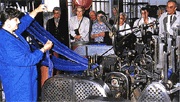|
|
|
|
Industrial
revolution & the |
|
Big mills
closed in the 1960s |
|
Big
mills closed in the 1960s Textiles, the garment industry, and fashion design are inextricably linked. The North is still a world centre for manufactured lace. Today there are many new jobs in distributing ready-to-wear clothing, especially in mail-order sales. |
|
|
Making
Textiles by machine The turmoil of the French Revolution in 1789 delayed industrial development - people with money fled the country, and life was too uncertain to invest in building new businesses. When Napoleon became Emperor, he encouraged industry, and his blockade protected the North's textile mills from English competition. They were quick to copy all the new British inventions as soon as spies spread news across the Channel. |
|
 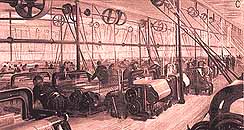 |
|
|
After Napoleon's final defeat at Waterloo
in 1815, more and more steam-powered mills were being built
in the North - again, often borrowing English inventions.
Cheap coal brought by canal barge from the Nord coal basin.
The Lille area became dirty with smoke and pollution. It was
like the Manchester of northern France - with equally
appalling and unhealthy slums. Roue à cabestan Sous l'Ancien Régime, le travail de la laine est organisé autour du marchand fabricant. Celui-ci achetait les laines aux Pays-Bas ou en Angleterre, les distribuait à des ouvriers à domicile. Les laines étaient stockées dans le grenier. On les hissait à l'aide d'une roue à cabestan. Il s'agit sans doute d'un dessin d'architecte proposé pour réaliser des travaux dans cette usine ou peut être d'une gravure qui servait à décorer la salle du conseil d'administration en tant que document de prestige. Actuellement, c'est l'IUT - B qui occupe cette ancienne filature, située rue Ste barbe à Tourcoing. A noter : l'architecture de cette usine est typique des " châteaux de l'industrie ", remarquable à sa tour qui associait la cheminée et l'escalier. Les serres qui se trouvaient au premier plan sont en réalité un système de refroidissement de l'eau (réfrigération).Le toit de cette usine présente également une originalité architecturale : on y voit des ouvriers vraisemblablement en train d'étendre des laines sur une plate-forme alors qu'habituellement les toits de ces usines étaient des toitures en sheds. La gravure est antérieure à la construction de la maison du propriétaire qui fut édifiée en face de la grille d'entrée. |
|
|
Ce dessin illustre le tissage de la laine, vraisemblablement au cours des années 1920. Les tisserands sont alors responsables de plusieurs machines. Les conditions de travail restent difficiles (chaleur, humidité et bruit). |
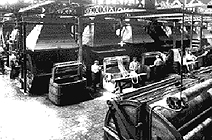 |
|
Rich
and poor |
|
  (left) 1884 - Railways served the huge factory of François Masurel Brothers in Tourcoing (right) Jean Masurel (1908-1991) used some of his enormous wealth as a patron of modern art - he gave his collection to found Lille's Modern Art Museum in 1997. |
|
|
La gravure est un témoignage de la construction de l'usine à proximité de la gare des Francs. Le train est utilisé comme moyen de transport des matières premières et pour l'expédition des produits manufacturés. Il est possible que les voies ferrées desservaient directement l'usine à l'intérieur de celle-ci. L'ensemble filature, teinturerie, et retorderie de laines peignées de cet établissement fut édifié en 1884. L'essor de la production est considérable : 1876 (1ère usine rue de Wailly) 45 000 Kg 1900 1 701 000 Kg 1920 2 075 000Kg 1930 3 865 000Kg 1950 5 041 000Kg A noter : une société de secours mutuels à participation mixte patronale et ouvrière, véritable modèle du genre créée en 1892. |
|
|
First
World War In the 1920's production boomed as the mills were rebuilt and re-equipped on modern lines using German war reparations money. But the world slump of the 1930's saw bitter strikes as owners sought to cut wages and worsen conditions. |
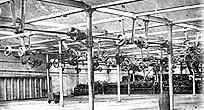 During the German occupation 1914-18, textile mills were stripped of machinery that was transported to Germany. |
|
Death
of textile mills |
|
|
Lace
industry |
|
|
Places
to visit: |
|
|
Related background
information |
|
|
|
|
|


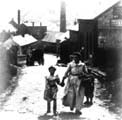 (left)
Mill pattern book, with samples of different cloths made:
textile makers had to keep up with fashion.
(right)
In the 19th century, women and children worked alongside men
in the textile mills.
(left)
Mill pattern book, with samples of different cloths made:
textile makers had to keep up with fashion.
(right)
In the 19th century, women and children worked alongside men
in the textile mills.
